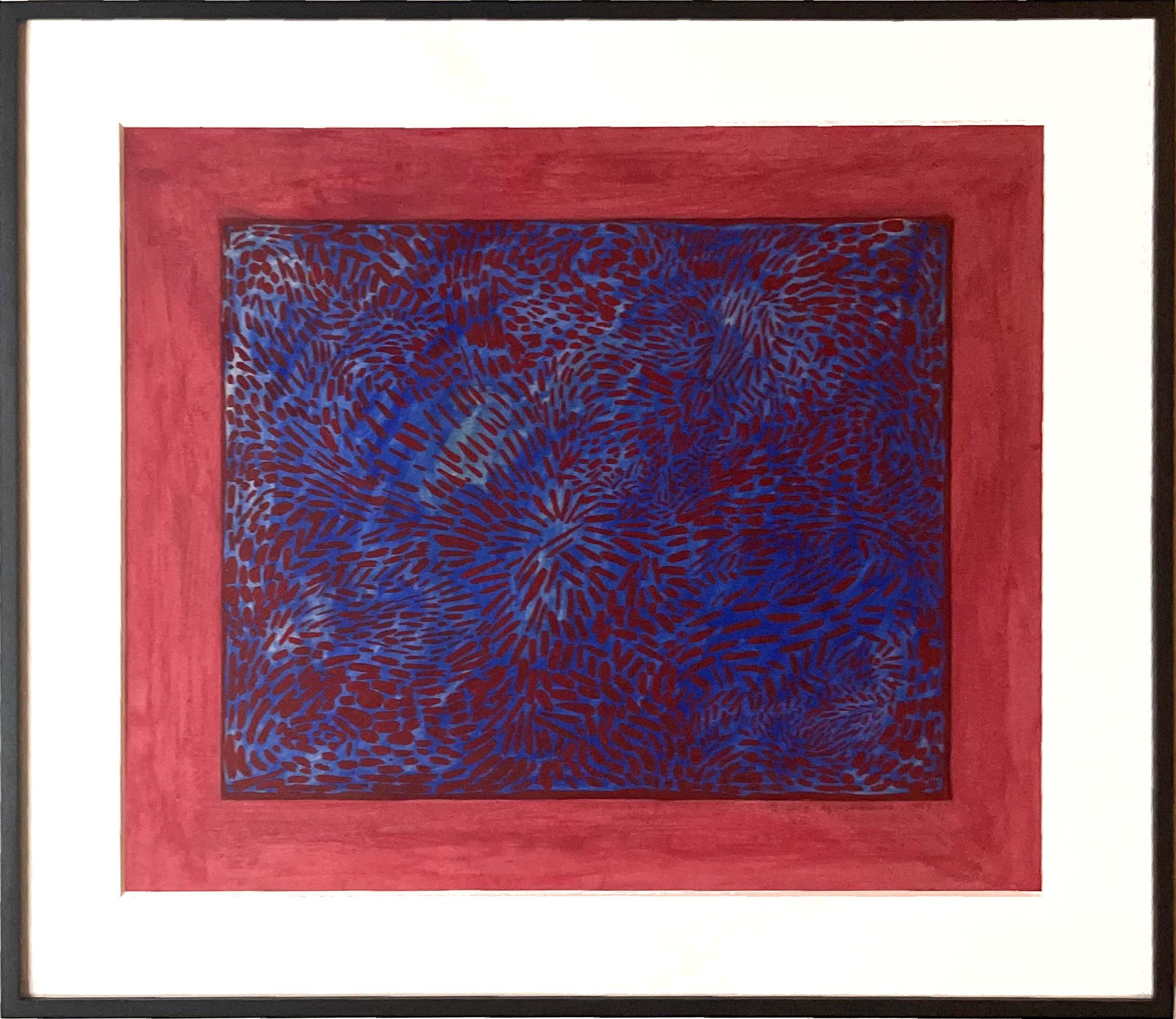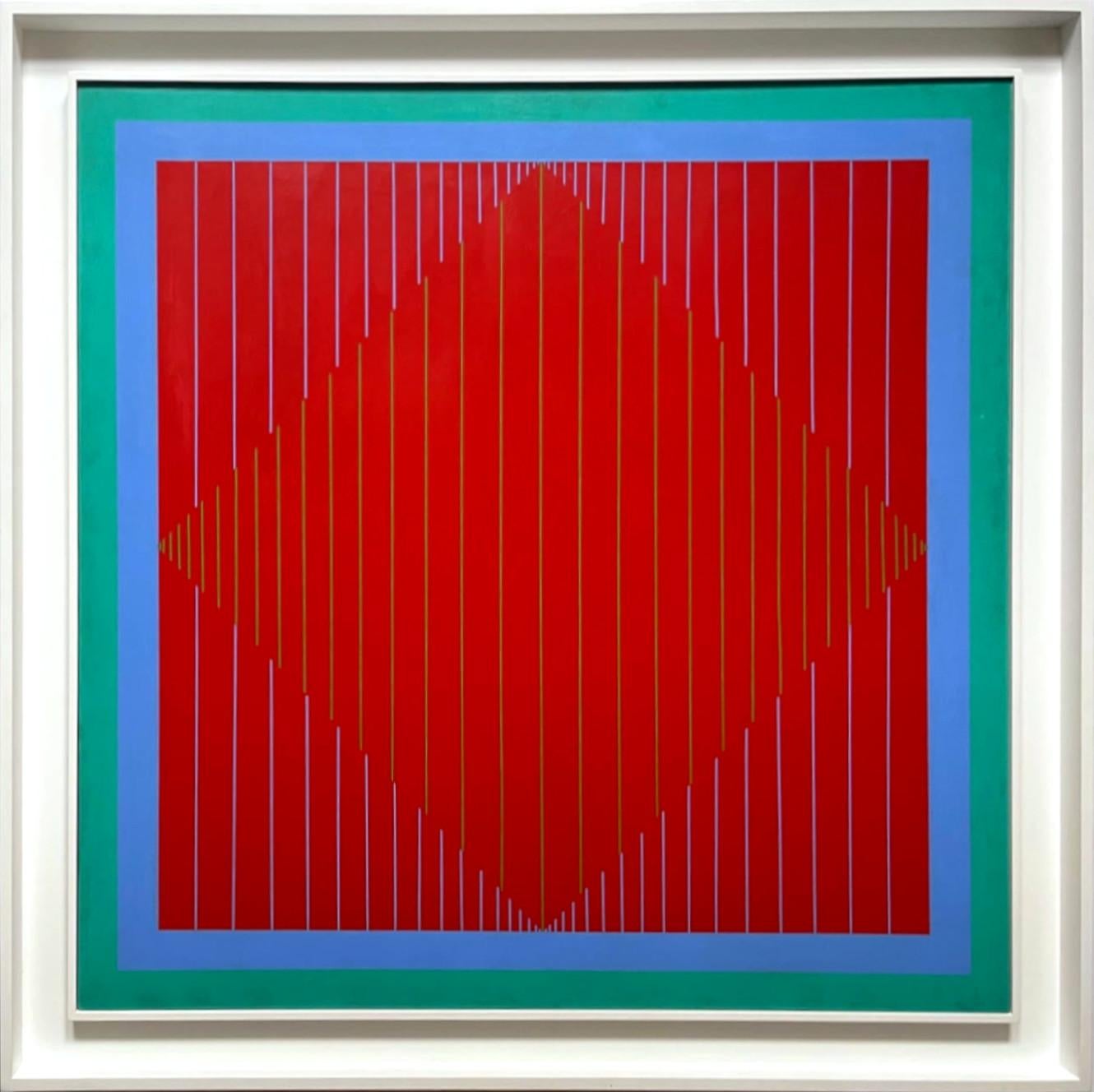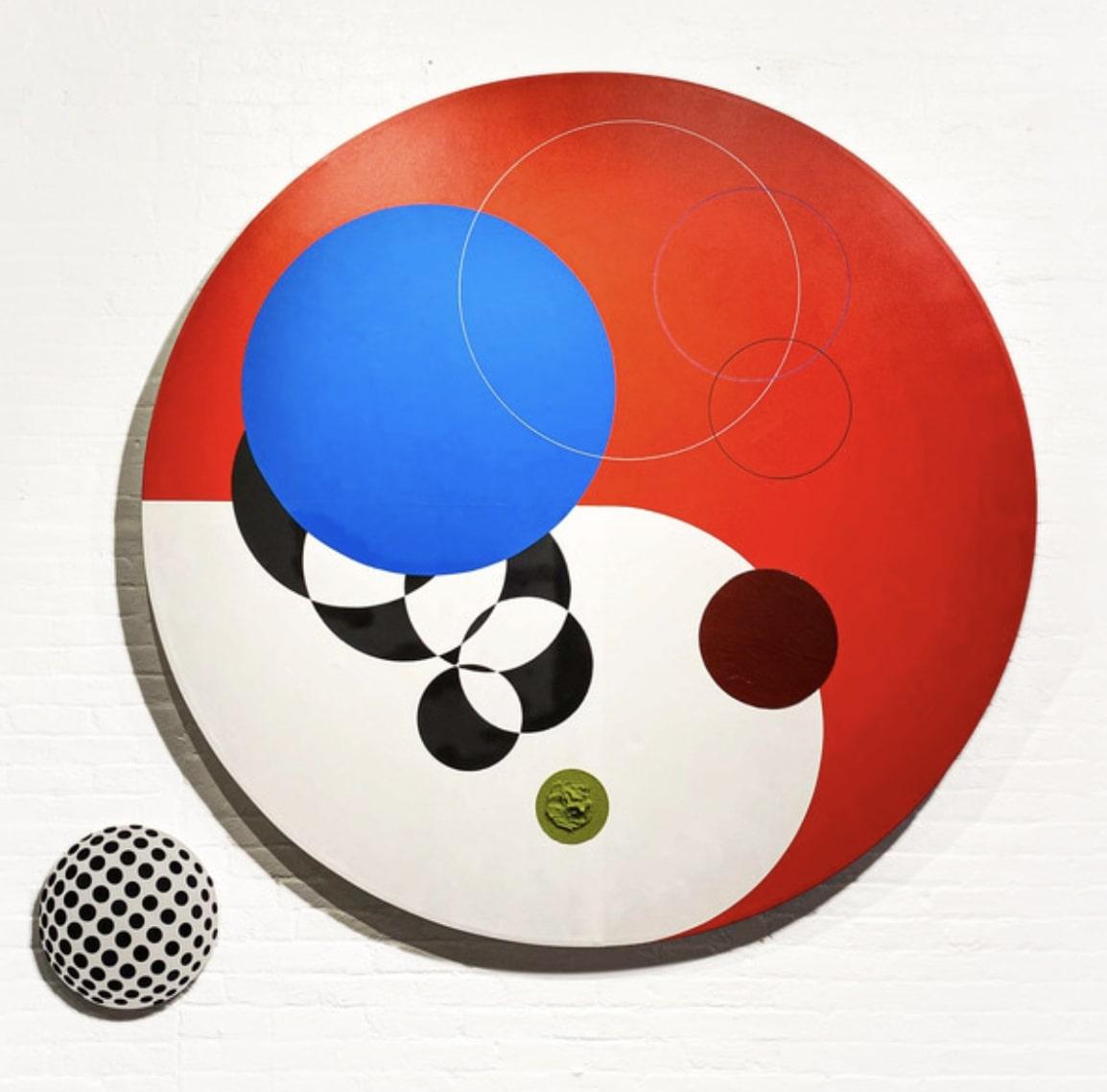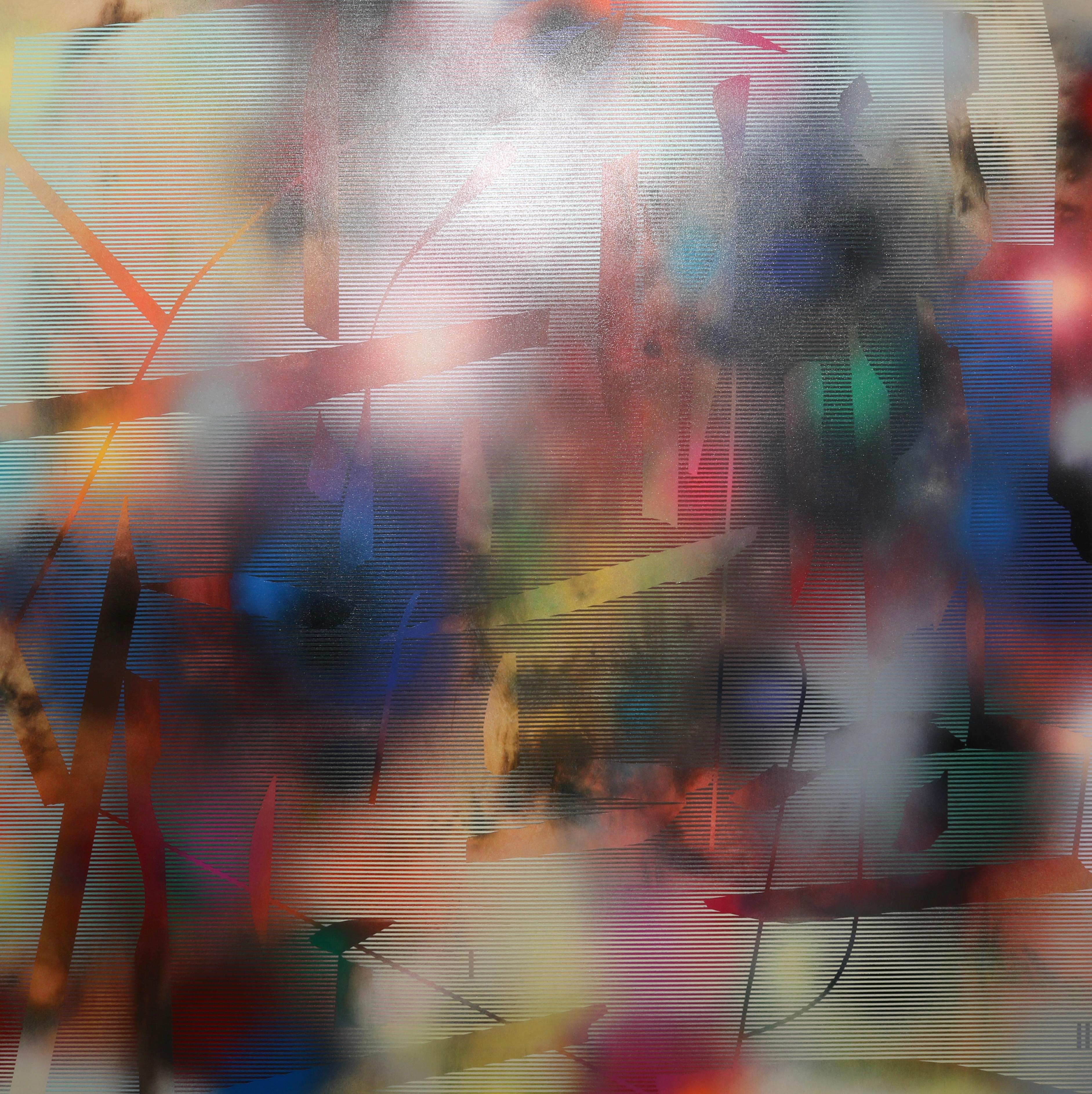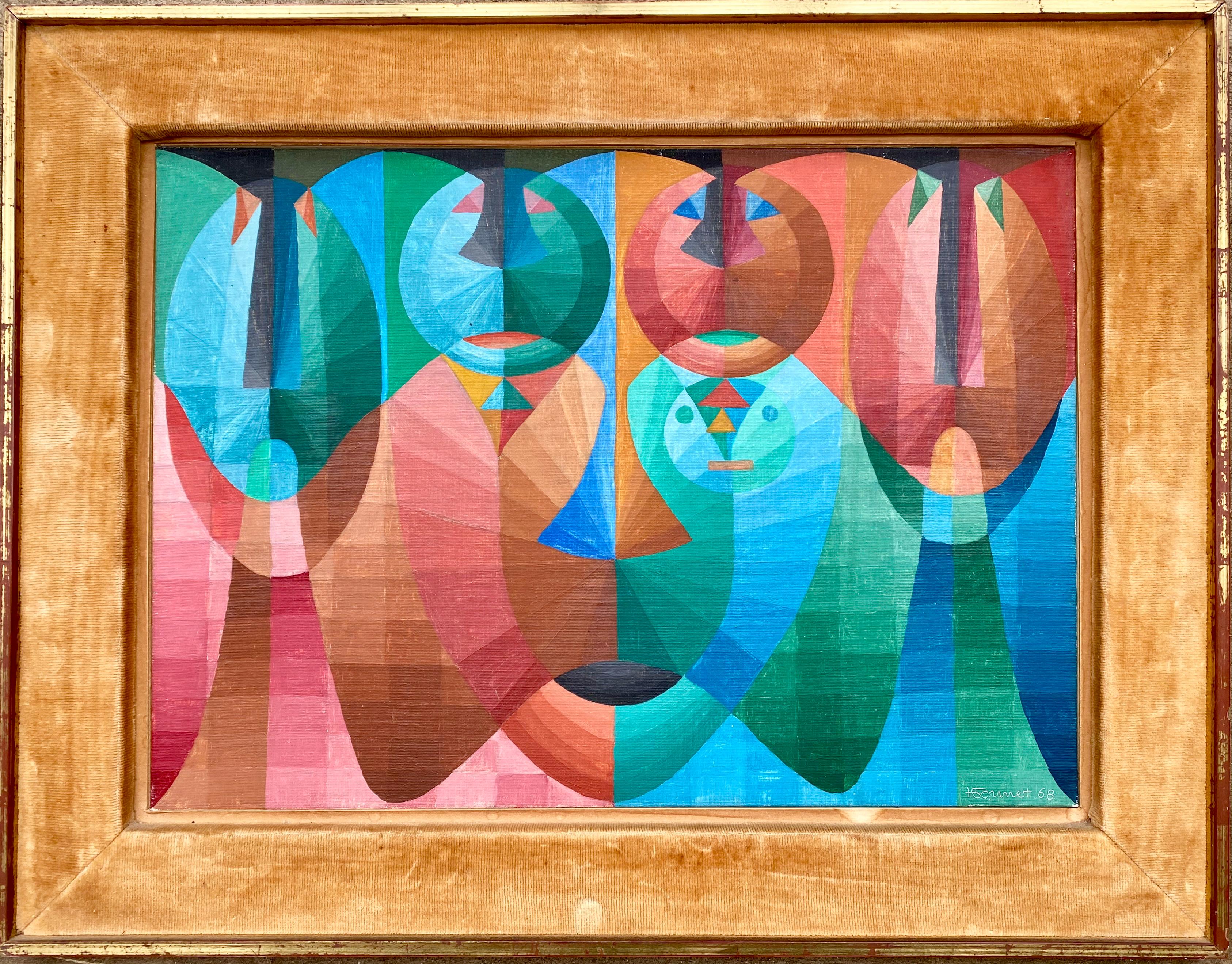Victor VasarelyVintage Chokk Mini C Original Op Art Vasarely Collage Painting
About the Item
- Creator:Victor Vasarely (1906 - 1997, French, Hungarian)
- Dimensions:Height: 24.75 in (62.87 cm)Width: 18 in (45.72 cm)Depth: 1.33 in (3.38 cm)
- Medium:
- Movement & Style:
- Period:
- Condition:
- Gallery Location:Surfside, FL
- Reference Number:1stDibs: LU38210820362
Victor Vasarely
Widely considered the grandfather of Op art, the French-Hungarian painter Victor Vasarely (1906–97) created eye-popping geometric abstractions that play with the viewer’s perception of depth, perspective and motion. A classic example is the 1937 Zebra, which consists of undulating black and white stripes that suggest the form of the titular animal through optical trickery. The work is often credited as the earliest Op art painting.
Such illusions were more than pleasing tricks for Vasarely, who insisted that “pure form and pure color can signify the world.” He wanted to “democratize” art by producing works in large editions at reasonable prices that were understandable across national and cultural boundaries. In the 1960s, he developed an alphabet plastique, or fine art alphabet, consisting of elementary visual building blocks that could be used in endless combinations to create original compositions. By employing this universal visual vocabulary and stripping away topical references, he sought to create what he called a “Planetary Folklore.”
Embodying Vasarely’s singular belief that art should serve a social function, accessible to all, these innovations may perhaps be his greatest contribution to 20th-century art.
Find a collection of Victor Vasarely prints, paintings, sculptures and other art on 1stDibs.
- ShippingRetrieving quote...Ships From: Surfside, FL
- Return PolicyA return for this item may be initiated within 3 days of delivery.
- 1970's Enamel Metal Vasarely Silkscreen Screenprint Axo Kinetic Op Art SculptureBy Victor VasarelyLocated in Surfside, FLVictor Vasarely (1908-1997) Axo This piece is hand signed and numbered circa 1972-1977 I have seen it described as enamel on steel and enamel on aluminium. it is a serigraph on meta...Category
1970s Op Art Abstract Paintings
MaterialsMetal, Enamel
- Op Art 1971 Kinetic Oil Painting Pop Art ArtistBy Josef LeviLocated in Surfside, FLJosef Alan Levi (1938) is an American artist whose works range over a number of different styles, but which are unified by certain themes consistently present among them. Josef Levi began his artistic career in the 1960s and early '70s, producing highly abstract and very modernist pieces: these employing exotic materials such as light fixtures and metallic parts. By 1975, Levy had transitioned to painting and drawing still lifes. At first these were, traditionally, of mundane subjects. Later, he would depict images from art history, including figures originally created by the Old Masters. Around 1980, he made another important shift, this time toward creating highly precise, though subtly altered reproductions of pairs of female faces which were originally produced by other artists. It is perhaps this work for which he is most well known. Since around 2000, Josef Levi has changed the style of his work yet again: now he works entirely with computers, using digital techniques to abstract greatly from art history, and also from other sources. Levi's works of art in the collections of the Museum of Modern Art, NYC, the National Gallery of Art, and the Albright-Knox Museum, among many others. Levi's art has been featured on the cover of Harper's Magazine twice, once in June 1987, and once in May 1997. Josef Levi received a Bachelor of Arts degree in 1959 from the University of Connecticut, where he majored in fine arts and minored in literature. From 1959 to 1960, he served to a first lieutenant in the U.S. Army, and from 1960 through 1967 he was in the U.S. Army Reserves. In 1966, he received the Purchase Award from the University of Illinois in 1966, and he was featured in New Talent U.S.A. by Art in America. He was an artist in residence at Appalachian State University in 1969, taught at Farleigh Dickenson University in 1971 and was a visiting professor of art at Pennsylvania State University in 1977. From 1975 to 2007, Levi resided in New York City. He now lives in an apartment in Rome, where he is able to paint with natural light as he was unable in New York. From 1959 to 1960, Josef took some courses of Howard McParlin Davis and Meyer Schapiro at Columbia University which initiated him into the techniques of reproducing the works of the Old Masters. His first works, created in the 1960s, were wood and stone sculptures of women. His first mature works were abstract pieces, constructed of electric lights and steel. In 1970, Levi's materials included fluorescent light bulbs, Rust-Oleum and perforated metal in addition to paint and canvas. By 1980, Josef Levi's art had transformed into a very specific form: a combination of reproductions of female faces which were originally depicted by other artists. The faces which he reproduces may be derived from either portraits or from small portions of much larger works; they are taken from paintings of the Old Masters, Japanese ukiyo-e, and 20th-century art. Artists from whom he has borrowed include: Vermeer, Rembrandt, Piero della Francesca, Botero, Matisse, Utamaro, Correggio, Da Vinci, Picasso, Chuck Close, Max Beckmann, Pisanello, Lichtenstein. The creation of these works is informed by Levi's knowledge and study of art history. Josef Levi's paintings from this period are drawn, then painted on fine linen canvas on wooden stretchers. The canvas is coated with twenty-five layers of gesso in order to produce a smooth surface on which to work. The drawing phase takes at least one month. Levi seals the drawing with acrylic varnish, and then he may apply layers of transparent acrylic in order to approximate the look of old paintings. After the last paint is applied, another layer of acrylic varnish is sprayed on to protect the work. Most of the figures in his contemporary pieces are not paired with any others. SELECTED COLLECTIONS MUSEUM OF MODERN ART, NEW YORK, NY ALBRIGHT- KNOX GALLERY, BUFFALO, NY ALDRICH MUSEUM OF CONTEMPORARY ART, RIDGEFIELD, CT NATIONAL GALLERY OF ART, WASHINGTON, DC BROOKLYN MUSEUM OF ART, BROOKLYN, NY SMITHSONIAN NATIONAL MUSEUM OF AMERICAN HISTORY, WASHINGTON, DC CORCORAN GALLERY, WASHINGTON, DC UNIVERSITY OF NOTRE DAME ART...Category
1970s Op Art Abstract Paintings
MaterialsCanvas, Oil
- Israeli 1970s OP Art Kabbala Painting "Jerusalem, 5732" (Star of David) JudaicaBy Yakov KaszemacherLocated in Surfside, FLYa'acov Kaszemacher, well-known artist and photographer whose unique images of Hassidic festivities are fascinating to view, and offer one an opportunity to peek into the community...Category
1970s Op Art Abstract Paintings
MaterialsOil
- Abstract mixed Media Collage Vibrant PaintingBy Armand SzainerLocated in Surfside, FLGenre: Contemporary Subject: Abstract Medium: Mixed Media Surface: Canvas Country: United States Dimensions: 32.25" x 24.25" commissions for movie advertisements, stage sets...Category
20th Century Abstract Expressionist Abstract Paintings
MaterialsMixed Media
- Modern Arab Abstract Islamic Calligraphy Modernist PaintingBy Wajih NahleLocated in Surfside, FLWajih Nahlé (1932-2017), born in Beirut, Lebanon,was a Lebanese Arab abstract painter and calligrapher. He studied painting in the workshop of the Lebane...Category
1990s Abstract Abstract Paintings
MaterialsMixed Media
- Abstract Landscape Arabic Mixed Media Colorful Collage Painting Arab CalligraphyLocated in Surfside, FLLarge mixed media on canvas composed of torn piece of burlap on canvas painted with a landscape scene of a city street, abstract shapes and shades and finished with glittered Arabic ...Category
1990s Abstract Abstract Paintings
MaterialsMixed Media
- Near and Far Acuity, Mid Century Modern Op Art painting from historic exhibitionBy Richard AnuszkiewiczLocated in New York, NYRichard Anuszkiewicz Near and Far Acuity, 1957 Gouache and watercolor painting Hand signed and dated 1957 by Richard Anuszkiewicz on the right front Frame included Anuszkiewicz' artworks from the late 1950s are rarely found on the market. This historic painting is one of the works that helped launch the artist's career. It was done in 1957 - the year the artist arrived in New York. Near and Far Acuity has been removed from its original frame, and re-framed in an elegant wood frame with conservation materials and UV plexiglass. The original gallery label from The Contemporaries has been preserved and affixed to the new backing, and the collector who acquires this work will also be provided with a copy of the original receipt - signed by Karl Lunde (director of the Contemporaries and author of a major monograph on the artist). Measurements: Frame: 32 x 28 x 2 inches Artwork: 21 x 25 inches This work was first exhibited in the groundbreaking, and career-making 1960 exhibition at The Contemporaries gallery (New York, February 29, 1960 - March 19, 1960) and was featured in the exhibition catalogue, shown in the images here. In his essay entitled "Richard Anuszkiewicz: Color Precisionist" by art historian John T. Spike, he writes, "In the spring of '57, Richard Anuszkiewicz left Ohio for good. "I was ready. I came to New York with a substantial amount of work. I was ready to go around to the galleries and I was prepared because I really had something. I had an idea. I had a series of paintings that showed this idea and I felt good about it and I felt now that's the only place for me to be." A friend helped him get a job touching up the plaster models of classical temples and statues in the Junior Museum of the Metropolitan Museum of Art. He took off six months the next year to travel around Europe in a Volkswagen, also seeing some places in North Africa. "When I came back, I remember taking my work around to the galleries and receiving interesting comments — positive comments from the various people. But Abstract Expressionism was very popular. My things were very hard-edged, very strong in color — a use of color that nobody was using. Everybody would say. 'Oh, they are nice, but so hard to look at. They hurt my eyes". Leo Castelli considered him seriously but the gallery was developing a specialization in pop artists like Jasper Johns and Robert Rauschenberg. "I can remember going to Martha Jackson and having her look at the work and she would put her hands straight out in front of her and block out parts of the painting with her hand and she'd say, mmm no rest areas." He finally caught on with The Contemporaries Gallery in the fall of 1959. The gallery at 992 Madison Avenue mainly represented new European talent. Karl Lunde, the gallery director, saw some of his canvases hanging...Category
1950s Op Art Abstract Drawings and Watercolors
MaterialsWatercolor, Gouache, Mixed Media
- Metallic Water, unique 1960s Op Art painting (signed), Art Institute of ChicagoBy Richard AnuszkiewiczLocated in New York, NYRichard Anuszkiewicz Metallic Water, 1964 Painting with Liquitex on canvas. (1964 Art Institute of Chicago Exhibition and J.L. Hudson Gallery) Signed boldly and dated 1964 on the ver...Category
1960s Op Art Abstract Paintings
MaterialsMixed Media, Acrylic, Canvas
- Alone in This Together by Andres Ciccone Represented by Prima GalleryLocated in New York, NYAlone in This Together by Andres Ciccone 80 in diameter Acrylic, Ink, Mixed Media, on CanvasCategory
21st Century and Contemporary Op Art Abstract Paintings
MaterialsCanvas, Ink, Mixed Media, Acrylic
- Cascadia 8 (grid painting abstract wood contemporary vivid colors optical art)By Melisa Taylor MetzgerLocated in Quebec, QuebecIn Melisa’s optical and pulsating compositions, the natural world acts as blue-print while she explores the notion of the sublime through blur and precision. The artist develops an a...Category
2010s Op Art Abstract Paintings
MaterialsSpray Paint, Wood Panel
- Jewel coloured vibrant op art abstract geometric painting French 1960sLocated in Norwich, GBA fabulous example of 1960s geometric/op art, displaying all the fun, playfulness and vibrancy of the style. Op art, short for optical art, is a style of visual art that uses optical illusions. Typically, they give the viewer the impression of movement, hidden images and vibrating patterns. Its roots can be traced back to Cubism, Futurism, Constructivism and Dada. The maker of this stunning piece is Tony Gonnet (1909-2004) an artist close to those who shaped modern art and its history. Working in Casablanca in 1940 he met André Breton and Saint-Exupéry, who were both on their way to America. Unable to obtain a visa for himself, Gonnet returned to Paris in January of 1942. Living on Rue de Seine, he became one of the figures of Saint-Germain-des-Prés and numbered amongst his many friends Jean-Paul Sartre, Simone de Beauvoir, Jean Genet – who prefaced his first Parisian exhibition in 1952 – as well as Albert Camus, Simone Signoret, Boris Vian, Jacques and Pierre Prévert and many others. In 1941, in the ennui of Casablanca, Tony Gonnet had started to draw, and then paint, in a Surrealist style. In 1946 he abandoned figurative surrealism in favour of abstraction, making sole use from then on of geometric forms and shaded tones, in his own unique style. His works aim to achieve harmony of shapes and colours, and thus to bring joy. Tony Gonnet loved life, and said that each of his works was an offering made to it. With solo shows in major Paris galleries...Category
1960s Op Art Abstract Paintings
MaterialsOil, Board
- "Space Cowboy II" Bright Teal, Neon Pink, and Dark Blue Circular PaintingLocated in Houston, TXColorful neon abstract contemporary circular painting by Houston, TX artist, David Hardaker. This painting features various rings of shades of neon teal...Category
2010s Op Art Mixed Media
MaterialsResin, Spray Paint, Acrylic

